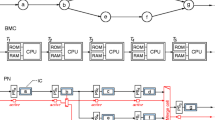Abstract
Several approaches have been proposed to early analyze the functional impact of a set of faults in a digital circuit, for a given application. These methods start with the RT-level description of the circuit and aim either at classifying the faults according to their main potential effect, or at analyzing more in depth the error propagation paths in the circuit. This paper discusses the advantage of combining the two types of analyses, on the basis of extensive SEU-like fault injections performed on a VHDL model of the 8051 micro-controller. The results show that this combination allows a designer to pinpoint critical locations, easing to improve hardening. The impact of the workload on the analysis is also discussed. It is shown that in the case of a general purpose processor, the internal error configurations leading to a failure can be very dependent on the application program; taking the application into account may therefore lead to a simpler and cheaper hardening of the circuit. The quality of the obtained results with respect to the number of injection experiments is also discussed. In a lot of cases, the injection of a very small percentage of all possible faults already gives very significant information to the designer.
Similar content being viewed by others
References
A. Ammari, R. Leveugle, M. Sonza-Reorda, and M. Violante, “Detailed Comparison of Dependability Analyses Performed at RT and Gate Levels,” in IEEE International Symposium on Defect and Fault Tolerance in VLSI Systems, Cambridge, Boston, MA, USA, Nov. 2003, pp. 336–343.
L. Berrojo, I. Gonzalez, F. Corno, M. Sonza-Reorda, G. Squillero, L. Entrena, and C. Lopez, “New Techniques for Speeding up Fault-Injection Campaigns,” Design, Automation and Test in Europe Conference (DATE), March 2002, pp. 847–852.
G.C. Cardarilli, F. Kaddour, A. Leandri, M. Ottavi, S. Pontarelli, and R. Velazco, “Bit-Flip Injection in Processor-Based Architectures: A Case Study,” 8th IEEE International On-Line Testing Workshop, Isle of Bendor, France, July 2002, pp. 117–127.
P. Civera, L. Macchiarulo, M. Rebaudengo, M. Sonza Reorda, and A. Violante, “Exploiting FPGA-based techniques for fault injection campaigns on VLSI circuits,” in IEEE International Symposium on Defect and Fault Tolerance in VLSI Systems, San Francisco, California, USA, Oct. 2001, pp. 250–258.
J. Gracia, J.C. Baraza, D. Gil, and P.J. Gil, “Comparison and Application of Different VHDL-Based Fault Injection Techniques,” in IEEE Int. Symposium on Defect and Fault Tolerance in VLSI Systems, San Francisco, California, USA, Oct. 2001, pp. 233–241.
R. Leveugle, “Fault Injection in VHDL Descriptions and Emulation,” in IEEE International Symposium on Defect and Fault Tolerance in VLSI Systems, Yamanashi, Japan, Oct. 2000, pp. 414–419.
R. Leveugle and K. Hadjiat, “Multi-Level Fault Injection Experiments Based on VHDL Descriptions: A Case Study,” 8th IEEE Int. On-Line Testing Workshop, Isle of Bendor, France, July 2002, pp. 107–111.
R. Leveugle and K. Hadjiat, “Multi-Level Fault Injections in VHDL Descriptions: Alternative Approaches and Experiments,” Journal of Electronic Testing: Theory and Applications (JETTA), vol. 19, no. 5, pp. 559–575, 2003.
F. Vargas, A. Amory, and R. Velazco, “Estimating circuit fault-tolerance by means of transient-fault injection in VHDL,”6th IEEE International On-Line Testing Workshop, Palma de Mallorca, Spain, July 2000, pp. 67–72.
Author information
Authors and Affiliations
Additional information
Abdelaziz Ammari received the DEA degree in Microelectronics from the University of Lyon, France, in 2002. He is currently member of TIMA laboratory and working towards a PhD at the National Polytechnical Institute of Grenoble (INPG), France. His main interests are dependable VLSI design and dependability analysis.
Karim Hadjiat received the DEA degree in Microelectronics from the University Joseph Fourier, Grenoble, France, in 2001. He is currently member of TIMA laboratory and working towards a PhD at the National Polytechnical Institute of Grenoble (INPG), France. His main interests are dependable VLSI design and dependability analysis.
Régis Leveugle received the PhD degree in Microelectronics from the National Polytechnical Institute of Grenoble (INPG), France, in 1990. He is currently Professor at this institute and member of TIMA laboratory. His main interests are computer architecture, VLSI design methods and CAD tools, fault-tolerant architectures, concurrent checking and dependability analysis. He has authored or co-authored more than 100 scientific papers and served as a reviewer for many journals and conferences. He has also served on several program and organization committees. He was General co-Chair for DFT’02, vice General Chair for IOLTW’02, Program co-Chair for DFT’01 and IOLTS’04, and vice Program Chair for IOLTS’03 and IOLTS’05. He is a member of IEEE.
Rights and permissions
About this article
Cite this article
Ammari, A., Hadjiat, K. & Leveugle, R. Combined Fault Classification and Error Propagation Analysis to Refine RT-Level Dependability Evaluation. J Electron Test 21, 365–376 (2005). https://doi.org/10.1007/s10836-005-0974-x
Received:
Revised:
Issue Date:
DOI: https://doi.org/10.1007/s10836-005-0974-x




